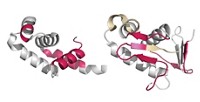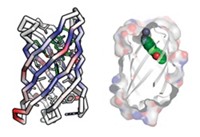Advertisement
Grab your lab coat. Let's get started
Welcome!
Welcome!
Create an account below to get 6 C&EN articles per month, receive newsletters and more - all free.
It seems this is your first time logging in online. Please enter the following information to continue.
As an ACS member you automatically get access to this site. All we need is few more details to create your reading experience.
Not you? Sign in with a different account.
Not you? Sign in with a different account.
ERROR 1
ERROR 1
ERROR 2
ERROR 2
ERROR 2
ERROR 2
ERROR 2
Password and Confirm password must match.
If you have an ACS member number, please enter it here so we can link this account to your membership. (optional)
ERROR 2
ACS values your privacy. By submitting your information, you are gaining access to C&EN and subscribing to our weekly newsletter. We use the information you provide to make your reading experience better, and we will never sell your data to third party members.
Biological Chemistry
A Designer Protein That Loves Metal
Computational Biology: Researchers use an unnatural amino acid to design a novel metal-binding protein.
by Erika Gebel Berg
August 22, 2013

Someday designer metal-binding proteins could catalyze chemical reactions unseen in nature for industrial and medical applications. Unfortunately, these proteins are difficult to create from scratch. Now, using computational design, researchers have generated a novel metal-binding protein by incorporating an unnatural amino acid with a taste for metals (J. Am. Chem. Soc. 2013, DOI: 10.1021/ja403503m).

None of the 20 amino acids typically found in proteins has a strong affinity for metals, says Jeremy H. Mills, a postdoctoral researcher in the laboratory of David Baker at the University of Washington, Seattle. So, metal-binding sites in natural proteins often contain several amino acids working together to grasp a metal. Mimicking that precise orientation of several amino acids poses a serious challenge in the design of metal-binding proteins, Mills says.
Baker, Mills, and their colleagues sidestepped the problem using an unnatural amino acid called (2,2’-bipyridin-5-yl)alanine, or Bpy-Ala, which has micromolar affinities for a variety of metals. At first, the team attempted to design an easy-to-express enzyme that mimicked the activity of catechol dioxygenase. This enzyme breaks down the environmental pollutant catechol, but is difficult to express in laboratories, Mills says.
They used computer programs to redesign catechol dioxygenase’s metal-binding site to include Bpy-Ala. Then, they searched a database of protein structures for ones that express well in Escherichia coli and could spatially accommodate the redesigned metal-binding site. With some small structural tweaks, the researchers identified five promising protein sequences.
After they expressed those designed proteins in E. coli, the researchers tested their ability to bind iron via a spectroscopic technique. Two of the proteins appeared to bind the metal, but when the researchers solved the structure of one using X-ray crystallography, they did not see the metal-binding site. Instead, the part of the protein containing the Bpy-Ala amino acid had twisted so that the unnatural amino acid jutted into solution. With the unnatural amino acid in the wrong position, the protein couldn’t catalyze the desired reaction.
Disappointed, the researchers set a humbler goal: design a protein that just binds metals. This time, they instructed their computer program to place Bpy-Ala within a more rigid part of the protein, such as within an α-helix. Such structures, according to Mills, “are less free to move around,” and more likely to lock the Bpy-Ala into place.
The strategy worked. They identified one easily expressed protein with about 250 amino acids that could bind iron, based on its spectroscopic signature. The crystal structure of the new protein matched their computer design almost exactly. Also the novel protein bound cobalt, zinc, and nickel, with affinities in the micromolar to picomolar range.
The match between the team’s designed structure and the X-ray crystal structure is impressive, says Huimin Zhao of the University of Illinois, Urbana-Champaign, as well as their use of an unnatural amino acid to create the metal binding site. The next step, he says, is to design a metalloprotein “that catalyzes a reaction that a natural protein cannot.”
That is Mills’ long-term goal, but for now he wants to make the catechol dioxygenase he set out to design in the first place.





Join the conversation
Contact the reporter
Submit a Letter to the Editor for publication
Engage with us on Twitter